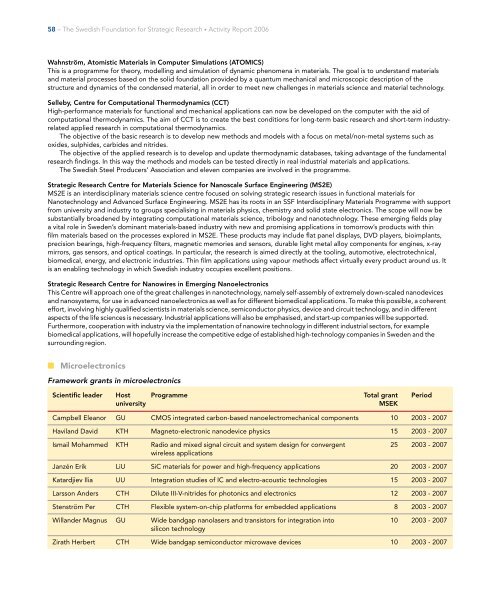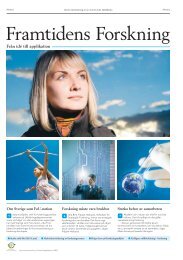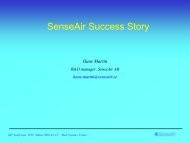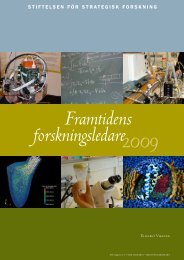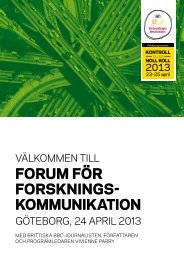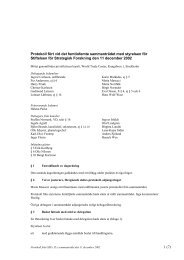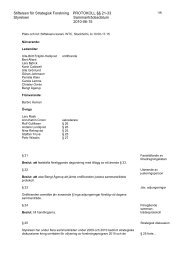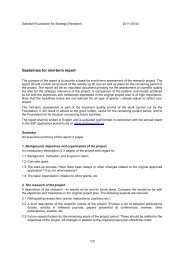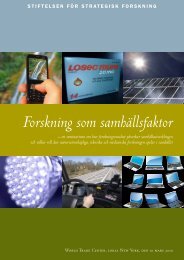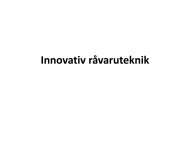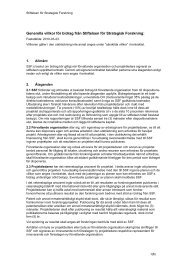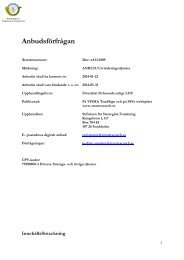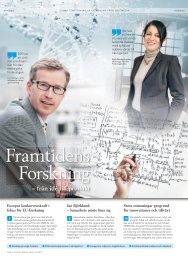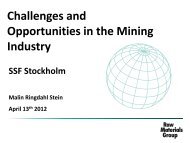Swedish Foundation for Strategic Research Activity Report 2006
Swedish Foundation for Strategic Research Activity Report 2006
Swedish Foundation for Strategic Research Activity Report 2006
Create successful ePaper yourself
Turn your PDF publications into a flip-book with our unique Google optimized e-Paper software.
58 – The <strong>Swedish</strong> <strong>Foundation</strong> <strong>for</strong> <strong>Strategic</strong> <strong>Research</strong> • <strong>Activity</strong> <strong>Report</strong> <strong>2006</strong>Wahnström, Atomistic Materials in Computer Simulations (ATOMICS)This is a programme <strong>for</strong> theory, modelling and simulation of dynamic phenomena in materials. The goal is to understand materialsand material processes based on the solid foundation provided by a quantum mechanical and microscopic description of thestructure and dynamics of the condensed material, all in order to meet new challenges in materials science and material technology.Selleby, Centre <strong>for</strong> Computational Thermodynamics (CCT)High-per<strong>for</strong>mance materials <strong>for</strong> functional and mechanical applications can now be developed on the computer with the aid ofcomputational thermodynamics. The aim of CCT is to create the best conditions <strong>for</strong> long-term basic research and short-term industryrelatedapplied research in computational thermodynamics.The objective of the basic research is to develop new methods and models with a focus on metal/non-metal systems such asoxides, sulphides, carbides and nitrides.The objective of the applied research is to develop and update thermodynamic databases, taking advantage of the fundamentalresearch findings. In this way the methods and models can be tested directly in real industrial materials and applications.The <strong>Swedish</strong> Steel Producers’ Association and eleven companies are involved in the programme.<strong>Strategic</strong> <strong>Research</strong> Centre <strong>for</strong> Materials Science <strong>for</strong> Nanoscale Surface Engineering (MS2E)MS2E is an interdisciplinary materials science centre focused on solving strategic research issues in functional materials <strong>for</strong>Nanotechnology and Advanced Surface Engineering. MS2E has its roots in an SSF Interdisciplinary Materials Programme with supportfrom university and industry to groups specialising in materials physics, chemistry and solid state electronics. The scope will now besubstantially broadened by integrating computational materials science, tribology and nanotechnology. These emerging fields playa vital role in Sweden’s dominant materials-based industry with new and promising applications in tomorrow’s products with thinfilm materials based on the processes explored in MS2E. These products may include flat panel displays, DVD players, bioimplants,precision bearings, high-frequency filters, magnetic memories and sensors, durable light metal alloy components <strong>for</strong> engines, x-raymirrors, gas sensors, and optical coatings. In particular, the research is aimed directly at the tooling, automotive, electrotechnical,biomedical, energy, and electronic industries. Thin film applications using vapour methods affect virtually every product around us. Itis an enabling technology in which <strong>Swedish</strong> industry occupies excellent positions.<strong>Strategic</strong> <strong>Research</strong> Centre <strong>for</strong> Nanowires in Emerging NanoelectronicsThis Centre will approach one of the great challenges in nanotechnology, namely self-assembly of extremely down-scaled nanodevicesand nanosystems, <strong>for</strong> use in advanced nanoelectronics as well as <strong>for</strong> different biomedical applications. To make this possible, a coherentef<strong>for</strong>t, involving highly qualified scientists in materials science, semiconductor physics, device and circuit technology, and in differentaspects of the life sciences is necessary. Industrial applications will also be emphasised, and start-up companies will be supported.Furthermore, cooperation with industry via the implementation of nanowire technology in different industrial sectors, <strong>for</strong> examplebiomedical applications, will hopefully increase the competitive edge of established high-technology companies in Sweden and thesurrounding region.n MicroelectronicsFramework grants in microelectronicsScientific leader Host Programme total grant Perioduniversity MmSEKCampbell Eleanor GU CMOS integrated carbon-based nanoelectromechanical components 10 2003 - 2007Haviland David KTH Magneto-electronic nanodevice physics 15 2003 - 2007Ismail Mohammed KTH Radio and mixed signal circuit and system design <strong>for</strong> convergent 25 2003 - 2007wireless applicationsJanzén Erik LiU SiC materials <strong>for</strong> power and high-frequency applications 20 2003 - 2007Katardjiev Ilia UU Integration studies of IC and electro-acoustic technologies 15 2003 - 2007Larsson Anders CTH Dilute III-V-nitrides <strong>for</strong> photonics and electronics 12 2003 - 2007Stenström Per CTH Flexible system-on-chip plat<strong>for</strong>ms <strong>for</strong> embedded applications 8 2003 - 2007Willander Magnus GU Wide bandgap nanolasers and transistors <strong>for</strong> integration into 10 2003 - 2007silicon technologyZirath Herbert CTH Wide bandgap semiconductor microwave devices 10 2003 - 2007


